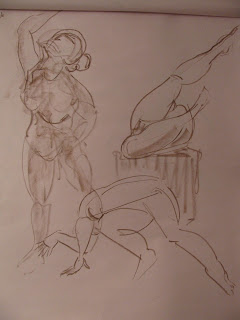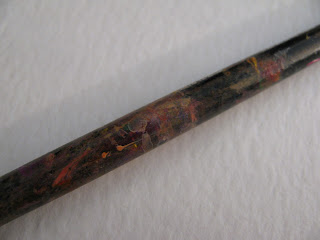After my thrilling May session at Vancouver's Basic Inquiry Studio, it was another month before I went again -- even though my original plan was to make this a weekly practice.
My second session in early July was just as affirming -- terrific model, excellent moderator, great studio layout. Without the angst of my initial visit, I moved with a little more confidence through the timed poses. Some samples:
One-minute poses:
Five-minute poses:
Ten-minute pose:
One of the final 30-minute poses:
I was fairly satisfied but also exhausted at the session's end. And sitting on the artist's donkey for three hours left me with a very uncomfortable behind -- it couldn't have been more so if I'd been sitting on one of the original bag-type bases of the schoolkids' baseball games of my childhood. (this link offers a fascinating more-than-you-ever-wanted-to-know history of baseball's bases!)
Thinking it over, I decided it was more realistic to aim for a session every other week. And next time I'd take a seat cushion! What's more, I realized I could pre-plan what I wanted to focus on in each session's poses of different durations. There are tons of ways to approach life drawing, and different drawing books, teachers, and my own inclinations have suggested different exercises.
Both the seat cushion and the "agenda" contributed to a fruitful and less tiring experience when I went again in mid-July. The model was an amply built woman who, like the two previous models, was amazing.
Some samples:
One-minute poses, alternating straight and curved lines:
Ten-minute poses, starting with a focus on "the main line that sets the pose" (not visible in the outcome, but the essential first step of my process):
Fifteen-minute poses, placed in positions that yield interesting "spaces between" (rather tricky since you don't know what pose the model will adopt next):
And the two final 30-minute poses in which I've just tried to keep it all together.
In my personal post-session evaluation, I had one more brilliant realization:-- It's summer, and summer won't last forever. So I might or might not settle in to an alternate week schedule until the good weather begins to fade. But I'm IN now. I'm a member. I have my member-discount tickets. And I'll be back!





















